
| THE
1997 BANKS MEMORIAL LECTURE Reproduced from an article by Brian Molloy From The New Zealand Garden Journal (Journal of the Royal New Zealand Institute of Horticulture), Vol. 3, No. 1, October 2000, pp. 13-18.
Riccarton Bush, in the
heart of the city of Christchurch, is arguably one of the oldest
and best documented protected natural areas in the country (Fig.
1). That this 7.8 ha remnant of kahikatea floodplain forest has
survived natural catastrophes and the impact of two human cultures
is extraordinary to say the least. It has done so largely by a combination
of its own intrinsic qualities and the foresight and dedication
of committed people, beginning with the Scottish settlers William
(1816-1851) and John (1820-1854) Deans in 1843. Today, Riccarton Bush stands as a constant reminder of the city's natural and cultural history, a living museum of native plants and animals, a storehouse of information on forest management, both good and bad, and an example of documentation by natural historians and others. Much of this information is captured in the book Riccarton Bush: Putaringamotu published by the Riccarton Bush Trust in 1995 (Molloy 1995). Here I want to focus on the management and sustainability of Riccarton Bush, but first a few historical and biological tidbits taken from the book to set the scene. Some historical facts about Riccarton Bush
|
|||||
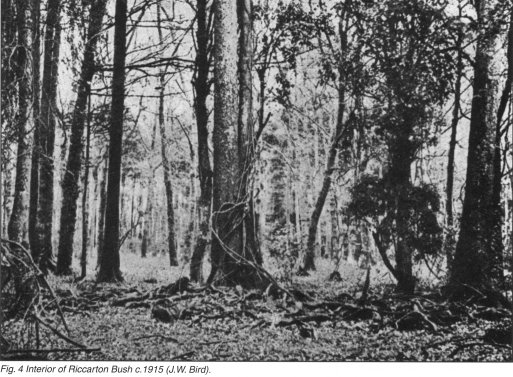 |
Early management of Riccarton Bush
During the Ngai Tuahuriri time of occupation, Riccarton Bush or Putaringamotu was a much-valued resource of plants and bird life. The likely impact of Maori use is difficult to assess and is very much open to speculation. Judging by early European descriptions of the Bush, the impacts appear to have been minimal, apart from the reduction in area by fires.During the 70 years of occupancy by the Deans' family, certain events and decisions taken were to shape the future of the Bush. Foremost was the felling of half the Bush by the Canterbury Pilgrims by agreement — one of the country's first examples of cutting rights. This clear-felling, together with the selected removal of kahikatea, totara and matai for building purposes, created a fresh boundary to the Bush and several large canopy gaps in the interior. To help offset the exposure of the Bush to the elements and to encourage the re-growth of native species, Jane Deans arranged for introduced trees, mainly oak and ash, to be planted along the boundaries and in the internal gaps from the late 1860s onwards. As Jane Deans noted, the introduced trees did well in the Bush, but instead of protecting young native plants, they tended to smother them out by their shade and fallen leaves.
First sixty years of trust board management
- 1914 — Riccarton Bush Trust Board took over the responsibility of the Bush, appointed its first ranger and decided not to open the Bush to the public until boundary fencing was completed, gates installed, a preliminary walking track put in place, and unwanted debris cleared.
- 1917 — Riccarton Bush opened to the public on 24 February 1917 by the Governor, Lord Liverpool. That same year the first plan of the Bush showing its present and former boundaries and the initial system of walking tracks was drawn up for the public's benefit.
- In 1914, and for many years afterwards, the Bush was in a dilapidated state (Fig. 4), and where trees had been extracted the associated debris and rapid growth of smothering climbing plants required much attention. Unfortunately, the Bush was treated like an English woodland, much of the debris was gathered up and burnt on the spot, and grassy clearings and the forest floor were regularly mown to produce a 'tidy' appearance.
- Initially the Bush was bounded by farmland. From 1925 onwards, this farmland was sold and sub-divided for residential housing. Over time, gates appeared along the boundary, private tracks were formed, garden refuse was dumped in the Bush, and excess runoff water accumulated. Apart from draining the excess water, these problems remained unresolved for many years.
- When the Trust Board took over in 1914 parts of the Bush were over-run by undesirable plants such as elderberry, blackberry, sycamore and many others. Disturbed parts of the Bush provided an ideal environment for this alien flora and the control of these unwanted plants has been an ongoing but important task.
- The initial track system became a permanent feature of the Bush and required constant care and attention. Some parts were systematically built up with hardfill, which introduced drainage problems in later years.
- Exotic trees planted in the Bush interior by Jane Deans were gradually removed, and by 1952 the last of these trees were felled. Some of the rotting stumps can still be seen today. The main border of oak and ash along the Bush boundary remained intact.
- The most extensive damage to the Bush during this period occurred in July 1945 when 45 cm of snow lay upon the ground in the city and suburbs. The debris in the Bush resulting from this storm was still being cleaned up in the late 1950s.
- The introduction of native plants to the Bush was one of the most critical activities carried out in this first phase of management. Sadly, it lacked adequate guidance and documentation, with the result that species not native to the region were often planted, in many cases the sources of plants were unknown, and hybridisation occurred between resident and introduced plants. One of the more invasive species, the North Island lacebark (Hoheria sexstylosa) became firmly established, displacing many of the local native trees and hybridising with the resident narrow-leaved lacebark (Hoheria angustifolia).
The last twenty-five years
From 1974 the Trust Board adopted a fresh approach to the management of Riccarton Bush in an attempt to turn around the unnatural and damaging effects of the previous 'woodland' phase, and to address other problems. As each project was undertaken, the public was kept fully informed and their support has been consistently strong.
- The boundaries of the Bush have now been secured by new fencing, thus eliminating private gates and walking tracks and the dumping of rubbish.
- A thorough soil and groundwater survey of the Bush has been completed, and the legal boundaries re- surveyed; both essential for management purposes.
- The problem of surplus water from adjoining properties has been resolved, and the ponding effect of the network of compacted tracks corrected.
- In 1974 the Bush was grossly over-tracked to the detriment of the forest environment and public use. Many of the tracks have now been closed, parts receiving the greatest use were replaced with concrete paths to provide an all-weather surface, especially for disabled folk, and a new boardwalk was constructed through the least disturbed part of the Bush.
- From 1974 the practice of gathering up litter and burning it in the Bush was stopped and all litter, including large fallen trees, is now left to rot naturally. The resultant buildup of forest litter has had a marked beneficial effect on the flora and fauna of the forest floor especially, and the micro-environment generally.
- From 1974 the practice of mowing grass clearings and the forest floor was also stopped. This practice was responsible for eliminating native climbing plants such as the white rata and white clematis, which were never abundant, and had caused considerable damage to the butts and large surface roots of kahikatea in particular. Fortunately most of this damage has callused over, although a few trees are now suffering from advanced butt rot.
- New entrances, signs, brochures and other items of interpretive value have been put in place, and a variety of studies are encouraged and supported.
- A consistent approach to the control of troublesome weeds and pests such as "urban" possums and domestic cats has been adopted, with considerable help with weed control by local groups.
- In 1975 the felling of oaks and other introduced trees on the Bush boundary was begun, and completed in 1984. This project, not without controversy from some neighbours, was carried out in stages and the cleared areas were prepared for minimal planting, allowing the Bush to spread naturally to the boundary of the reserve in the years ahead.
- In 1975 work began on the establishment of a nursery for propagating plants from seed sourced entirely from the Bush. Over the following years numerous plants of understory trees such as karamu, ribbonwood, matipo, mapou, lemonwood and others were planted in clearings and along the boundary to provide initial shelter for naturally spreading trees to establish and to suppress the growth of grasses and other weeds.
- Initial plantings in 1975 were monitored from fixed photo points, and their subsequent growth proved to be rapid and dramatic (Fig. 5).
- More recently a large-scale project removing the North Island lacebark from the Bush has been undertaken with considerable success and with the help of local organisations and interest groups.
- It is anticipated that the practice of new planting in gaps throughout the Bush will continue for several years yet, and to this end the nursery has been re-organised to cope with the demand, and also to supply surplus plants for other projects around the city.
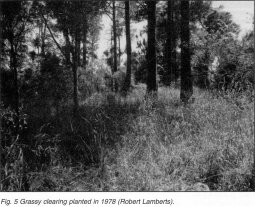 |
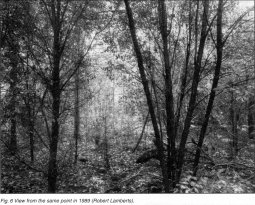 |
|
Conclusion
In the last 25 years Riccarton Bush has demonstrated the remarkable resilience of small forest remnants and their inherent capacity to respond to simple and sensible management practices. The lessons learned throughout the Trust Board's stewardship are now embodied in a management plan adopted in 1991 and reviewable at the Board's discretion. In my time I have been astounded by the rapidity and magnitude of the changes in Riccarton Bush in response to the management practices put in place. Substantial parts of the Bush are now difficult to distinguish from undisturbed forests elsewhere in the country. There is still a way to go before the Bush becomes completely self-sustaining, but I am confident this will happen if the present management continues. We all realise that Riccarton Bush is now completely isolated from normal processes of replenishment and the direction of change it will take will differ accordingly. Our main object is to restore the Bush to a state where natural processes can take over. Compared to its earlier open woodland condition, the Bush now has a continuous cover of woody plants, herbs and ground ferns, and in places is quite impenetrable. The dramatic increase in vegetation generally now places greater demand on soil moisture, particularly during exceptionally dry summers, and also increases the risk of fire. With this in mind, the Trust Board's next major project is to install a permanent, dual irrigation/ fire protection system as an insurance against fire, and more especially for the maintenance and enhancement of the Bush.
Over the last 25 years my association with Riccarton Bush, representing the Canterbury Branch of the Royal Society of New Zealand, has been a most fulfilling experience. I thoroughly recommend a similar commitment to forest remnants elsewhere in the country.
References
Deans, J. 1882. Canterbury past and present. New Zealand Country Journal 6 (6): 381-392.
Molloy, B. (ed) 1975. Riccarton Bush: Putaringamotu. Riccarton Bush Trust, Christchurch.
![]()
Web-notes: Other sites that feature Riccarton Bush
Home | Journal
| Newsletter | Conferences
Awards | Join
RNZIH | RNZIH Directory | Links
© 2000–2025 Royal New Zealand Institute of Horticulture
Last updated: March 13, 2003

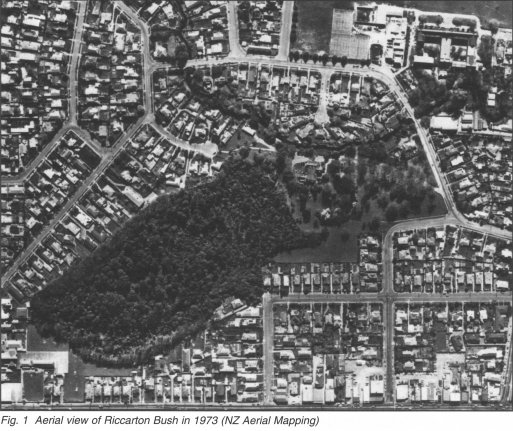
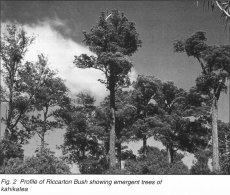 Some
biological features of interest
Some
biological features of interest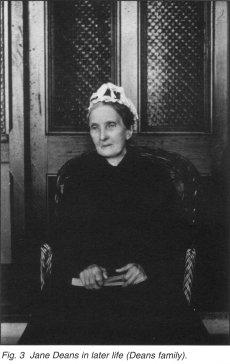 Survival
and protection of Riccarton Bush
Survival
and protection of Riccarton Bush